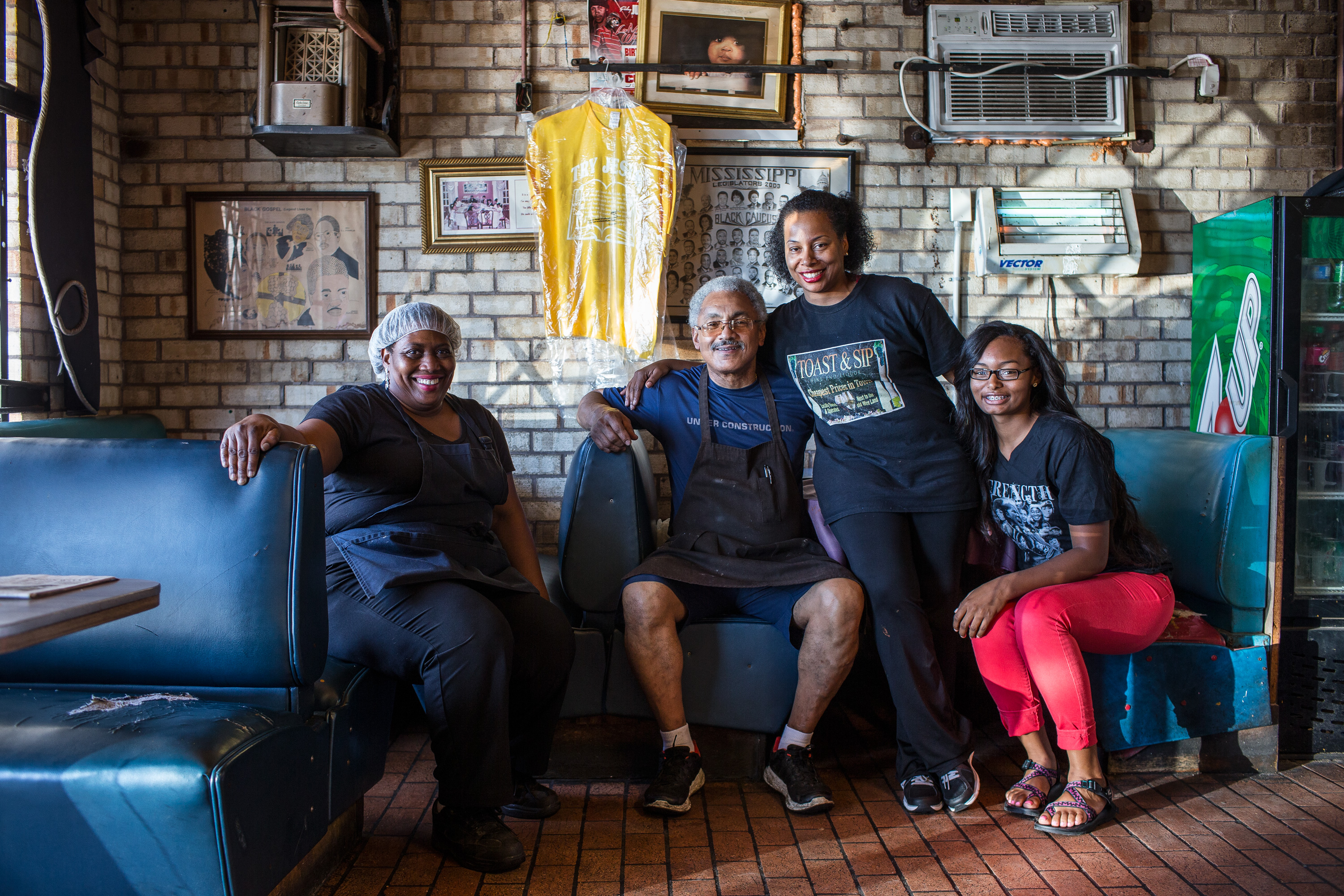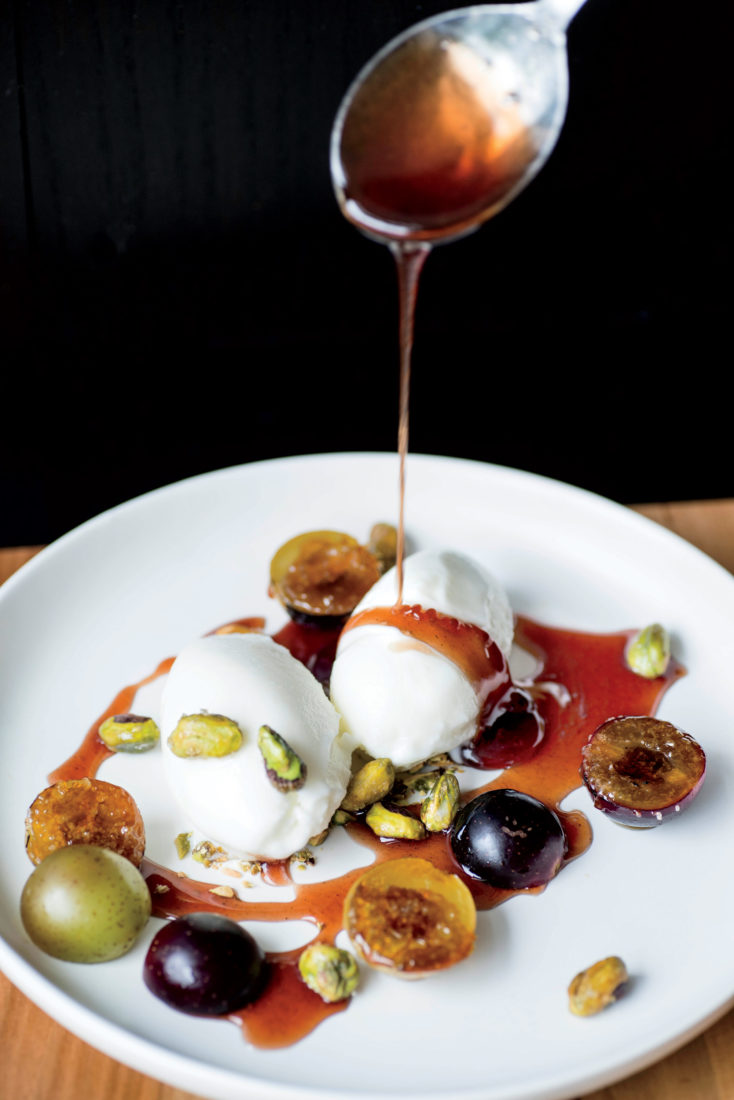Food & Drink
John T. Edge’s Top Ten Dishes of 2014
From greens done right to a sublime sundae composed like a work of art, these 2014 favorites are a tasty look at the vibrancy and variety of what today’s Southern chefs are cooking up

Illustration: Illustrations by Jason Schneider
When Thelonious Sphere Monk, a native of Rocky Mount, North Carolina, played bebop in New York City clubs in the 1960s, he tucked a collard leaf in his jacket lapel to remind him of the farm from which he sprang. Based on my time at table in 2014, supping at working-class bunkers and white-tablecloth temples from Houston to Raleigh, I can make a case that crucifers are, once again, vogue. Today, instead of waving flags, Southerners broadcast our mores and morals when we grow, cook, and serve the foods of our peoples.
The time is right. Meat-and-threes—the restaurants that serve weekday feasts of one meat and three vegetables to the grandchildren of plow hands—are renascent after a long doldrum. And entrepreneurs are now exploring the possibilities of the form. The other day, I stopped at Bubba Ray’s Quick Country Kitchen in Jasper, Alabama, a meat-and-three chain in the making. Six SUVs idled in the drive-through. When I tapped the driver-side window to ask a startled soccer mom what she ordered, the ponytailed thirtysomething told me meat loaf, mashed potatoes, green beans, and creamed corn. “No fries?” I asked. “We got cornbread,” she said in a tone that telegraphed she was trying to convince her children that such a swap was not only virtuous but equitable.
Eat your way through the roster that follows and you’ll recognize that chefs across the region are taking their cues from meat-and-threes, and old-guard purveyors are winning new converts to the pleasures of black-eyed peas and potlikker. But not all the dishes I urge you to eat in 2015 are vegetable driven or meat-and-three inspired. A sophisticated smoked oyster dish from Charleston, South Carolina, is in the bunch. So is a great ham sandwich, dripping with cheese, served alongside a palm-shrouded Miami Beach pool. In Memphis I favor a cornbread riff with roots in the Deeper South, namely Venezuela. And in Chapel Hill, North Carolina, I introduce you to an ice cream sundae that floats in its bowl like a cloud suspended in a cloud. All taste of this place and this time, in which food serves the region as an inclusive totem, and collards are worthy boutonnieres.

Photo: Whitney Ott
Cinnamon roll nirvana.
Listed in no particular order:
Sweet Potato Cinnamon Roll
The Farmer’s Daughter
Chattanooga, TN
Picture a pastry geode with a craggy exterior. Now crack open that glaze-enrobed roll to reveal a golden interior, veined with auburn lashes of cinnamon. As wisps of sweet and earthy vapors stream toward the glossy white ceiling, picture the nearby farm on which tiny sweet potato slips grew into leafy and leggy plants. And fix on the knotty roots that gained purchase in the ground. Then bite. And taste what happens when a sweet potato reaches its sweeter potential.
Ann Keener, daughter of farmer Bill Keener—who raises livestock and crops all sorts of vegetables at nearby Sequatchie Cove—is the lead cook in this mostly female kitchen. Sweet potatoes are her favorite. She also bakes butternut squash cinnamon rolls. Both play well off lattes of locally roasted coffee, crowned with frothed Cruze Dairy milk, served in this wedge of a onetime filling station.
Photo: Whitney Ott
The counter at the Farmer’s Daughter in Chattanooga, TN.
1 of 3
Photo: Whitney Ott
2 of 3
Photo: Whitney Ott
3 of 3
Luck and Money
Poole’s Downtown Diner
Raleigh, NC
I had eaten my fill of peas and greens earlier that week. On New Year’s Day, as I’m supposed to. As you’re supposed to. Peas for luck. And greens for money. When I glanced at Poole’s chalkboard menu three days later, I ordered Luck and Money anyway. Good menu writing always gets me. I asked Ashley Christensen, chef and owner of Poole’s, about the coinage. “Luck and money are recipes for changing reality,” she told me as she worked the black lacquer dining room, slapping backs and smiling big.
The ingredients are familiar: collards, sometimes mustards and turnips too, cut with good cider vinegar; braised with onions, garlic, and chiles; stirred with a hillock of pink-eyed peas that Christensen and her crew put up over the summer; and capped with a fat dollop of roasted garlic compound butter. But the results are combustive. Something alchemical happens in this muddy bowl. Something like fission, if atom splitting encompassed matters of greens and peas. The bang is big.

Photo: Lissa Gotwals
Feeling Lucky
Greens meet peas in the New Year’s-friendly Luck and Money at Poole’s.
Smoked Oysters and Saltines
The Ordinary
Charleston, SC
Smoked quickly over alder wood until their edges curl, tucked into a squat glass vase, garnished with coriander-perfumed crème fraîche, the oysters in chef Mike Lata’s elegant dish arrive with a deck of twice-baked crackers. Those oysters are sophisticated and understated. They are haute and unfettered. They are bliss.
That mix is rare in people. And in food. Too often chefs believe great foods require grand flourishes. Here, the meekest details resonate. Delicate, like a cross between a fern and a flower, the celadon leaves that tassel on the tips of celery stalks deliver a crystalline accent to the briny wash of those oysters. They conjure, too, the humble work of a top-of-his game chef, bent over a diminutive casserole, with a bouquet of celery in hand.

Photo: Peter Frank Edwards
Smoking Good
Smokey oysters get the royal treatment at the Ordinary.
Cachapa
Arepa & Salsa
Memphis, TN
“It’s not like our cornbread,” says the waitress who delivers the cheese-threaded cachapa to my table. “But it’s good.” She mostly gets it right. The cachapas made at Arepa & Salsa in midtown Memphis by the Venezuela native Marguel Polania and her crew are like the hoecakes fried in cast-iron skillets by grandmothers from Virginia to Texas.
Thanks to the fresh mozzarella that the cooks spread across the surface before folding the corn cake into a crescent that recalls a fat quesadilla, they’re even better. This de facto Venezuelan national dish celebrates the Americas, both south and north of the isthmus. So do the posters of Venezuelan jazz stars that line the green and yellow walls of this humble café. They say jazz was born in North America. And maybe the hoecake was too. But good food knows no borders.

Photo: Rett Peek
A cachapa at Arepa & Salsa.

Photo: Chris Granger
The team at Bully's Restaurant.
Three Greens Plate
Bully’s Restaurant
Jackson, MS
Walk into Bully’s before the mansard-roofed restaurant opens for lunch and you spy Jacqueline Tard, a thirty-year veteran prep cook and waitress. Each morning, she stands before a table in the dining room, stripping stems and washing grit from collard greens. In the kitchen, Remi Oladipo, a Nigerian immigrant who first met the Bully family at church, cores and chops cabbage. On the stove, a battered aluminum kettle, mounded with mustards and turnips, burbles and spits potlikker.
This is back-of-the-range cooking without peer. Doing business since 1982, Tyrone Bully and his crew simmer down three fresh greens every day. Pocked with all manner of pig parts from hocks to tails, those soft and leathery crucifers draw a steady stream of Jackson police officers, Hinds County deputies, Mississippi state legislators, and everyday folks. This concrete-block restaurant is like a museum of honest and soulful country cooking. And those greens eat like sustaining artifacts, showcasing the expert labor of dedicated cooks and the judicious application of smoked and cured pork.
Photo: Chris Granger
Tray Chic
Fresh-cooked greens with cornbread at Bully’s, in Jackson, Mississippi.
1 of 5
Photo: Chris Granger
The menu at Bully’s Restaurant.
2 of 5
Photo: Chris Granger
The dining room inside Bully’s Restaurant.
3 of 5
Photo: Chris Granger
A regular patron dines-in at Bully’s.
4 of 5
Photo: Chris Granger
The exterior of Bully’s Restaurant, in Jackson, Mississippi.
5 of 5
Fried Shrimp
Speed’s Kitchen
Shellman Bluff, GA
The distance from the fry basket to my table is twelve feet. Heat pulses off the pink crescents of cornmeal-crusted shrimp. I nibble the crisp tails like appetizers and pause before the main event. The smell of clean oil floats on the air in the low-ceilinged dining room. From the step-down kitchen, I can hear the low rumble of the fryer. And the treble of the owners, Karen Burns and Linda Howard, as they dish gossip and bang pots.
Set in a trio of Spanish moss–shrouded house trailers that were seemingly dropped into the coastal loam like pick-up sticks, Speed’s has been frying shrimp and stewing oysters since the 1970s. The stew is stupendous. I taste oysters, milk, butter, and nothing more. The shrimp are just as elemental. When I bite, I taste what skilled and single-minded cooks can accomplish with sweet crustacean meat, harvested from nearby waters and treated with restraint and respect. Burns and Howard only open Thursdays through Sundays, and they close each year in late November. But don’t fret. They’re back at the fry baskets by mid-January.
Greek Meatballs
Johnny’s
Homewood, AL
The menu says meatballs. Timothy Hontzas, scion of a large Greek family with a long restaurant history, calls them keftedes. They decode as a grind of beef and pork, scented with thyme, oregano, sumac, and mint, and they taste like gyro meat that worked its way through night school to earn a postgraduate degree. Especially when slathered with tzatziki, which Hontzas makes by culturing his own yogurt and adding chopped cucumbers, garlic, and dill.
They taste, too, like a short history of Greek immigration to Jackson, Mississippi, where Hontzas’s forebears alighted, and Birmingham, where a cadre of his countrymen have long run the city’s best meat-and-threes. Named for his grandfather, Johnny’s is a new-generation meat-and-three, run by a chef who sources from the same farms that Birmingham fine-dining restaurants tap. Round out those meatballs with cracker-crumb-topped squash casserole, specked butter beans stewed with slabs of carrots, and mashed potatoes flecked with skins. You’re in the hands of a master.
Photo: Melina Hammer
Meat and a Sweet Tea
Keftedes with house-made tzatziki and a grit cake at Johnny’s.
1 of 2
Photo: Melina Hammer
Owner, Timothy Hontzas at Johnny’s.
2 of 2
Cubano
Delano Beach Club
Miami Beach, FL
Poolside at this swank beachfront hotel, men bare shaved and greased chests. And many of the bikinied women appear augmented. But the Cubanos—stuffed with pork and Swiss, smeared with yellow mustard, layered with pickles, and doused with sandalwood-scented mojo sauce—are anything but baroque. They are everyday indulgences, proof that great sandwiches, served with aplomb, are passkeys to alfresco happiness.
Toasted on a ridged panini press, presented on a banana-leaf-lined white tray with a stack of chips, these may not be the absolute best Cuban sandwiches you eat in Miami. That mythical Cubano can be sought in the back-alley joints off Calle Ocho. Served amid a jungle of well-trimmed foliage, as a crew of solicitous waiters and waitresses wend through the chaise longues and a DJ scratches out a beat, these stacks of bread and pork and cheese deliver something more profound: the best eating experience in Miami Beach.
Brûléed Muscadine Sundae
Lantern
Chapel Hill, NC
This ethereal dessert tastes like a bubble bath feels, which is to say it’s poofy, indulgent, and luxurious. At Lantern, the chef and owner, Andrea Reusing, focuses the flavors of Asia through the prism of the North Carolina Piedmont. Yadira Rivera-Torres, the pastry chef, embraces that same vision, showcasing a delicacy rooted in Japanese design, wherein less is more.
Here, she references and reinvents the sundae, enrobing a quenelle of crème fraîche ice cream with pistachio-kissed whipped cream, drizzling star-anise-scented red wine caramel, and scattering toasted pistachios. Tucked in what sounds like a complex assemblage, but playing across the palate like a koan to simplicity, is a foxy brace of halved muscadine grapes lacquered with turbinado sugar. Trust me. You’ll never miss the banana.

Photo: Lissa Gotwals
Lantern’s brûléed muscadine sundae.
Black Pepper Spaghetti
Coltivare
Houston, TX
If you were recently a child, or if you recently raised a child, then you’re fluent in buttered noodles with cheese. It’s the chicken finger of pasta dishes, an innocuous feat of calorie delivery engineering, standard in every restaurant from Olive Garden to your local temple of gastronomy. This is not that.
This is a dangerous dish, strafed with butter-toasted Tellicherry peppercorns that taste like double-barrel buckshot must feel when it hits your backside. On first bite, nothing really happens. Then comes the sting. And soon a warmth blossoms. Ryan Pera, the young chef at this Texan-Italian trattoria, knows that heat like that begs for balance. So, after boiling fatter-than-average spaghetti in a short pot, he whisks a cirrus of grated Parmesan into a puddle of starchy pasta water until a silken sauce coalesces. The resulting tangle is at once aggressive and sublime.




















